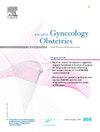Foetal achondroplasia: Prenatal diagnosis, outcome and perspectives
IF 1.7
4区 医学
Q3 OBSTETRICS & GYNECOLOGY
Journal of gynecology obstetrics and human reproduction
Pub Date : 2025-02-01
DOI:10.1016/j.jogoh.2024.102891
引用次数: 0
Abstract
Background
Achondroplasia, due to a specific pathogenic variant in FGFR3, is the most common viable skeletal dysplasia and the diagnosis is mostly done in the prenatal period. Since 2021, the use of Vosoritide, a specific treatment for achondroplasia, validated in phase 3 placebo-controlled trials, has been recommended to significantly increase the height of children and infants. In the light of these new therapeutic prospects, a complete understanding of the pathophysiology of skeletal damages occurring from foetal life is required.
Objectives
To describe foetal imaging and the antenatal and postnatal management of pregnancies complicated by a diagnosis of foetal achondroplasia.
Methods
A retrospective and descriptive study, including all pregnant women with a prenatal diagnosis of achondroplasia, was conducted in the prenatal unit of Necker Hospital (Paris, France) between 2009 and 2022. Maternal and obstetric characteristics and foetal imaging (ultrasound and bone CT) were collected. Pregnancy outcomes, paediatric follow-up in the case of live births, and post-mortem examination (PME) data in the case of termination of pregnancy were reported. In addition, we have prospectively developed a specific research protocol using foetal brain MRI to assess the anatomy of the foramen magnum, following the same approach currently recommended in the postnatal period.
Results
29 cases of achondroplasia were included. Median gestational age at referral was 31+2 weeks’, about 1 week after the suspected diagnosis on routine ultrasound. Shortening of the femoral length and of all the other long bones, macrocephaly, facial abnormalities, increased metaphyseal-diaphyseal angle and tapering of the proximal femoral bone were the five most prevalent ultrasound signs. Foetal diagnosis was done by the identification of the foetal FGFR3 mutation and/or by CT scans (n = 15) where specific abnormalities of the long bones, platyspondyly and abnormal profile have been described in 100 % of cases. PME revealed: i) on external examinations (n = 7) that all fetuses had very short long bones, moderate platyspondyly, small iliac wings with internal spines, macrocrania, and narrow thorax, ii) on internal examination (n = 5) all had severe abnormalities in the growth plate and particularities in the temporal cortex and hippocampal region. One foetal MRI was performed at 33 weeks’ and revealed tight stenosis of the foramen magnum and compression of the spinal cord. Of the live-born infants for whom follow-up was known (n = 6), 2/6 (including the case who had a foetal MRI) required neurosurgical intervention in the first few months of life for spinal cord compression due to severe stenosis of the foramen magnum.
Conclusion
A complete mapping of the skeletal features present in foetuses with achondroplasia is reported here, providing a better understanding of the pathophysiology of this condition. New tools such as foetal MRI, to assess the risk of postnatal severe neurological complications, could help improve the care pathway of the affected neonates.
胎儿软骨发育不全:产前诊断,结果和观点。
背景:软骨发育不全,由于FGFR3的特定致病变异,是最常见的可存活的骨骼发育不良,诊断大多在产前完成。自2021年以来,Vosoritide(一种治疗软骨发育不全的特殊药物,在3期安慰剂对照试验中得到验证)被推荐用于显著提高儿童和婴儿的身高。鉴于这些新的治疗前景,需要对胎儿期发生的骨骼损伤的病理生理学有一个完整的了解。目的:描述胎儿成像和产前和产后处理妊娠合并诊断的胎儿软骨发育不全。方法:回顾性和描述性研究,包括所有产前诊断为软骨发育不全的孕妇,于2009年至2022年在法国巴黎内克尔医院产前科进行。收集产妇和产科特征及胎儿影像(超声和骨CT)。报告了妊娠结局、活产的儿科随访和终止妊娠的尸检(PME)数据。此外,我们前瞻性地开发了一种特定的研究方案,使用胎儿脑MRI来评估枕骨大孔的解剖结构,遵循目前在产后推荐的相同方法。结果:29例软骨发育不全。转诊时的中位胎龄为31±2周,约为常规超声疑似诊断后1周。股骨和其他长骨长度缩短、头大畸形、面部异常、干骺端-干骺端角度增加和股骨近端骨变细是5个最常见的超声征象。胎儿诊断是通过鉴定胎儿FGFR3突变和/或CT扫描(n=15)完成的,其中100%的病例描述了长骨、脊椎骨和异常轮廓的特定异常。PME显示:1)外部检查(n=7)所有胎儿都有非常短的长骨,中度平椎,小髂翼带内棘,大颅,窄胸;2)内部检查(n=5)所有胎儿都有严重的生长板异常以及颞叶皮质和海马区的特殊性。孕33周时进行一次胎儿MRI检查,发现枕骨大孔狭窄,脊髓受压。在已知随访的活产婴儿中(n=6), 2/6(包括有胎儿MRI的病例)在出生后几个月内因枕骨大孔严重狭窄导致脊髓受压而需要神经外科干预。结论:本文报道了软骨发育不全胎儿骨骼特征的完整图谱,为更好地理解这种疾病的病理生理学提供了依据。新的工具,如胎儿核磁共振成像,评估产后严重神经系统并发症的风险,可以帮助改善受影响的新生儿的护理途径。
本文章由计算机程序翻译,如有差异,请以英文原文为准。
求助全文
约1分钟内获得全文
求助全文
来源期刊

Journal of gynecology obstetrics and human reproduction
Medicine-Obstetrics and Gynecology
CiteScore
3.70
自引率
5.30%
发文量
210
审稿时长
31 days
期刊介绍:
Formerly known as Journal de Gynécologie Obstétrique et Biologie de la Reproduction, Journal of Gynecology Obstetrics and Human Reproduction is the official Academic publication of the French College of Obstetricians and Gynecologists (Collège National des Gynécologues et Obstétriciens Français / CNGOF).
J Gynecol Obstet Hum Reprod publishes monthly, in English, research papers and techniques in the fields of Gynecology, Obstetrics, Neonatology and Human Reproduction: (guest) editorials, original articles, reviews, updates, technical notes, case reports, letters to the editor and guidelines.
Original works include clinical or laboratory investigations and clinical or equipment reports. Reviews include narrative reviews, systematic reviews and meta-analyses.
 求助内容:
求助内容: 应助结果提醒方式:
应助结果提醒方式:


